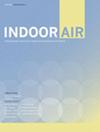雾霾条件下服装对室内PM的累积与扩散——以郑州市为例
IF 4.3
2区 环境科学与生态学
Q1 CONSTRUCTION & BUILDING TECHNOLOGY
引用次数: 0
摘要
衣服可以吸收室外大气中的细颗粒物污染物,进入室内后以类似于三手烟的形式释放出来。本研究以中国中部典型重污染城市郑州市为实验场地,研究涤纶、涤棉和棉质服装三种不同面料对细颗粒物污染物的吸附和扩散规律,指导人们的行为模式和室内空气分布,减少室内污染暴露。结果表明,三种不同面料的服装分别暴露于中、重度PM2.5污染中1 h、2 h、3 h,然后转移到扩散室,在同一释放周期内,涤纶向室内空气释放的PM2.5浓度最高,其次是棉、涤棉。此外,室内空气污染物的浓度会受到服装面料吸附的细颗粒物扩散的周期性影响。随着室外污染程度的增加和暴露时间的延长,衣物转移到室内后,室内PM2.5浓度稳定在一定水平需要更长时间。最后,通过与自然通风实验的对比,证明单纯依靠自然通风来改善服装污染源对室内空气质量的影响是不可行的。本文章由计算机程序翻译,如有差异,请以英文原文为准。
Accumulation and Diffusion of PM from Outdoor to Indoor by Clothing under Haze Conditions: A Case Study of Zhengzhou, China
Clothing can absorb fine particulate pollutants from the atmosphere outdoors and then release them after entering the room in a form similar to three-handed smoke. In this study, the experimental site in Zhengzhou, a typical city with heavy pollution in central China, was used to investigate the adsorption and diffusion patterns of three different fabrics of polyester, polyester-cotton, and cotton clothing for fine particle pollutants, to guide people’s behavior patterns and indoor air distribution, and to reduce indoor pollution exposure. The results showed that when garments of three different fabrics were exposed to moderate and heavy PM2.5 pollution for 1 h, 2 h, and 3 h, respectively, and then transferred to the diffusion chamber, polyester always released the highest PM2.5 concentration to indoor air during the same release cycle, followed by cotton and polyester-cotton. In addition, the concentration of indoor air pollutants will be periodically affected by the diffusion of fine particulate adsorbed by clothing fabrics. With the increase in outdoor pollution and exposure duration, the indoor PM2.5 concentration takes longer to stabilize at certain levels after the clothing is transferred to the indoor side. Finally, the comparison of natural ventilation experiments proved that it is not feasible to rely solely on natural ventilation to improve the influence of clothing pollution sources on indoor air quality.
求助全文
通过发布文献求助,成功后即可免费获取论文全文。
去求助
来源期刊

Indoor air
环境科学-工程:环境
CiteScore
10.80
自引率
10.30%
发文量
175
审稿时长
3 months
期刊介绍:
The quality of the environment within buildings is a topic of major importance for public health.
Indoor Air provides a location for reporting original research results in the broad area defined by the indoor environment of non-industrial buildings. An international journal with multidisciplinary content, Indoor Air publishes papers reflecting the broad categories of interest in this field: health effects; thermal comfort; monitoring and modelling; source characterization; ventilation and other environmental control techniques.
The research results present the basic information to allow designers, building owners, and operators to provide a healthy and comfortable environment for building occupants, as well as giving medical practitioners information on how to deal with illnesses related to the indoor environment.
 求助内容:
求助内容: 应助结果提醒方式:
应助结果提醒方式:


